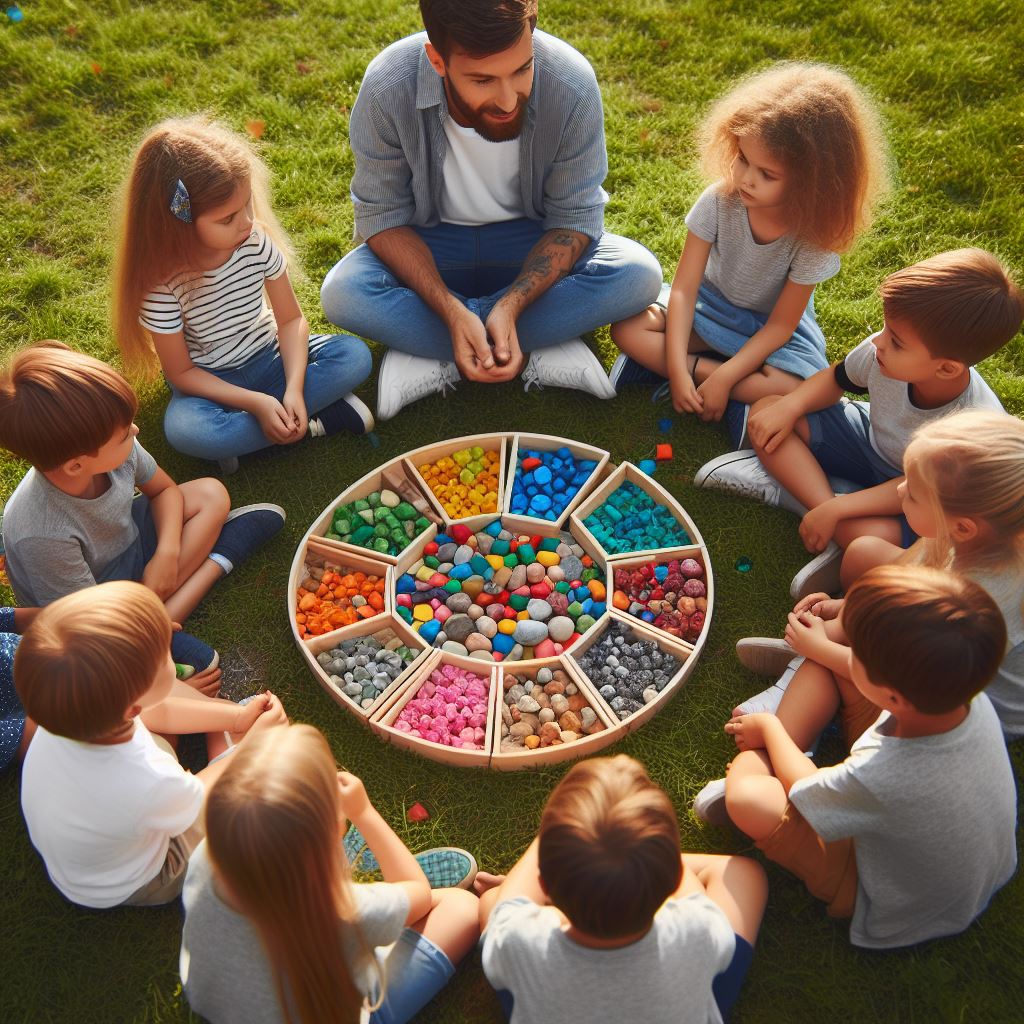
Rock On! Games and Activities for Kids Using Rocks
You have likely walked past countless rocks without giving them much thought. However, rocks can be a source of fun and learning if you know how to use them. With a bit of creativity, you can turn ordinary rocks into toys and tools for games that will engage children’s minds and bodies. In your backyard or neighbourhood, you can find rocks to sort, paint, play tic-tac-toe, make dominoes, and tell stories with. The variety of shapes, textures, and colours make each rock unique. Simple, natural rocks can build observation skills, strategy, creativity, logic, math, and more when incorporated into kids activities. With just rocks from the ground and some basic supplies, you are ready for a day of screen-free, educational play. In this article, you will learn five ways to turn rocks into toys for learning games and activities with your kids.
Rock Sorting: Sorting Rocks by Colour, Shape and Size
Rock sorting is one of the simplest activities that helps children develop observational and classification skills. You can have children sort rocks by various attributes like colour, shape, texture, size or weight.
Here are some simple rock sorting activities to try:
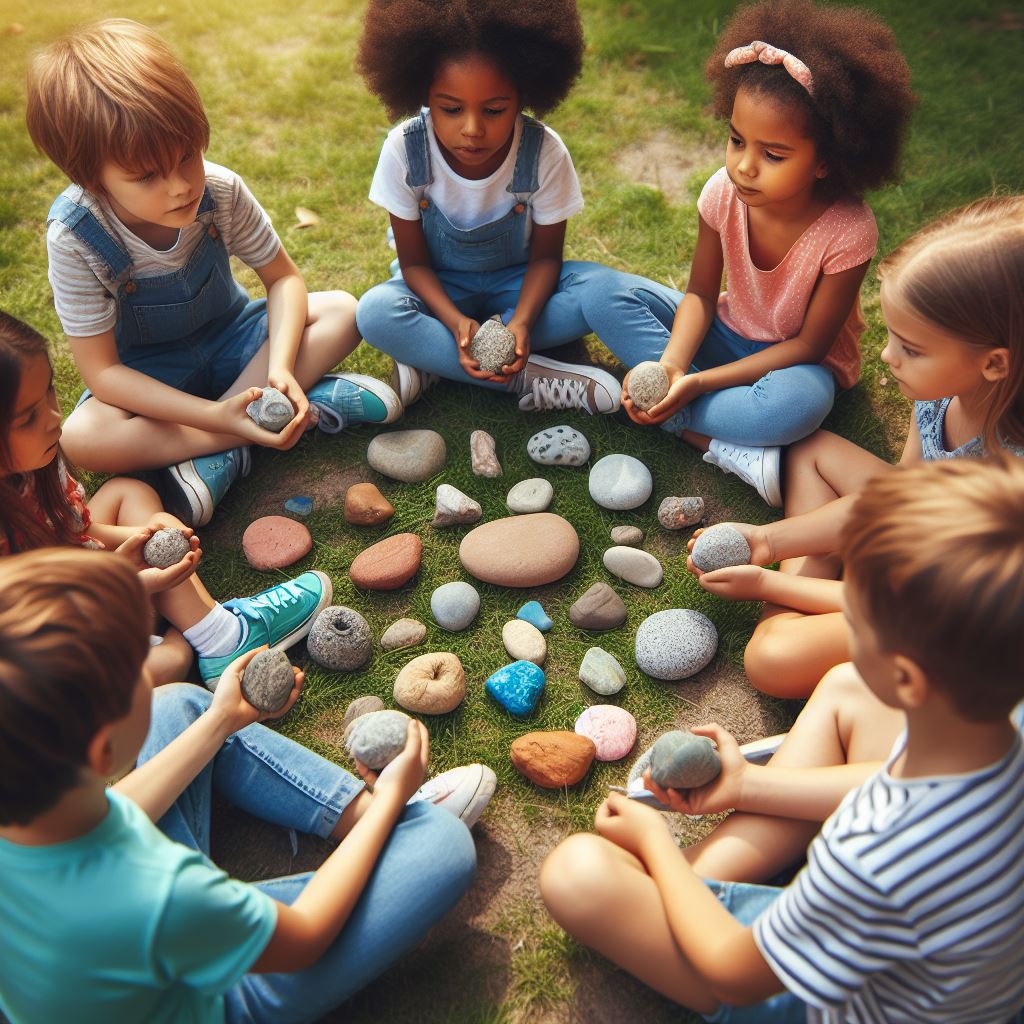
Sorting by Colour
Have the children gather a collection of rocks in different colours from the ground. Provide containers like buckets or bowls in different colours. Ask the children to sort the rocks by colour into the matching containers. This helps develop colour recognition and sorting skills. As an extension, you can ask the children to count how many of each colour rock they found.
Sorting by Shape
Gather a variety of rocks in different shapes. Provide containers or sections marked with different shapes like circle, square, triangle and rectangle. Ask the children to place each rock in the matching shape section. This helps children learn basic shapes and how to classify objects. Count the number of rocks in each shape section as an extension activity.
Size and Texture
You can continue with more rock sorting ideas based on size and texture. Remember to ask open-ended questions as the children sort to build their thinking and language skills. Sorting rocks in different ways provides an enriching outdoor experience full of learning opportunities for kids.
Colour
Have children group rocks by colour into categories such as red, blue, green, brown, black, white, etc. This helps them identify different hues and shades. You can also have them arrange rocks from light to dark to understand colour gradation.
Shape
Sorting rocks by shape – round, oval, cube, pyramid, etc. – helps children identify different geometric forms in nature. Have them describe how the shapes differ and think of objects with similar shapes. This strengthens their visual-spatial skills.
Size
Arranging rocks from smallest to largest or largest to smallest by size helps children understand the concept of size progression and measurement. Have them estimate the size difference between rocks using informal units like ‘the size of a pebble/stone/boulder’. This builds a sense of scale and proportion.
Other Attributes
You can also have children sort rocks by texture (smooth, rough, bumpy), lustre (shiny, dull), pattern (striped, spotted) or weight (heavy, light). Sorting by multiple attributes at once, e.g. shiny blue rocks and dull red rocks, helps children recognise how properties intersect.
Rock sorting activities open up opportunities for children to be creative in their classification and descriptive skills. Encourage children to explain their sorting rationale and think of new attributes to categorise rocks. Most importantly, make sorting fun by turning it into a game. The child with the most categories or largest collection wins!
Rock Painting: Unleashing Your Creativity on Rocks
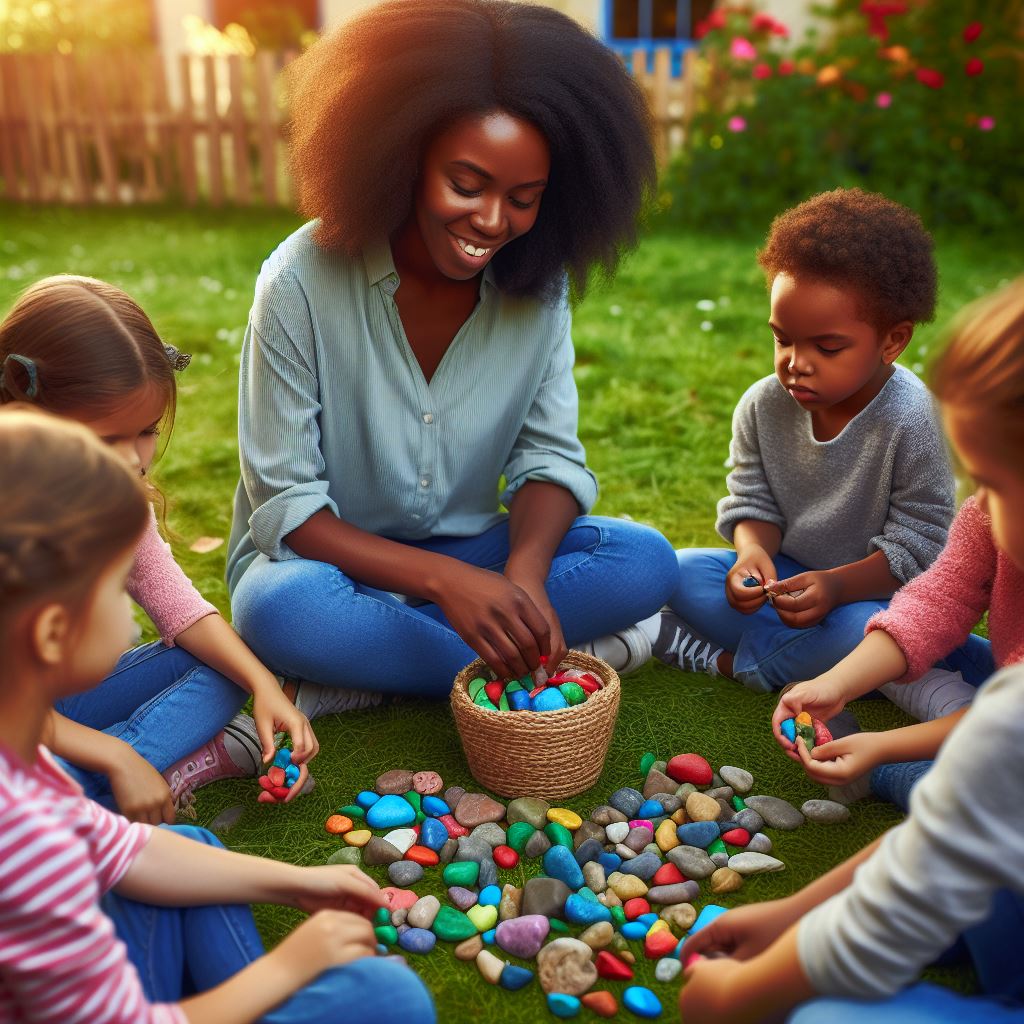
Rock painting is an enjoyable activity for both kids and adults that allows you to express your creativity. You can turn ordinary rocks into colourful works of art using paint, markers, stickers or whatever materials you have on hand. The possibilities are endless!
Designing Your Rocks
When designing your rocks, think about what shapes, animals or objects they remind you of. You can then enhance these features by painting the details. For example, a rock with bumps could become a caterpillar, or an oval-shaped rock may look like an egg. Let your imagination run wild!
Choosing Your Medium
Acrylic paints, tempera paints, and watercolours all work well for rock painting. Permanent markers also provide bright colours. For younger kids, stickers are a great option. Apply a sealant like mod podge over the paint or stickers to protect your designs.
Practising New Skills
Rock painting helps children and adults practise skills like creativity, self-expression and problem-solving. Coming up with unique designs for each rock and bringing them to life challenges you to think outside the box. The final results can boost confidence and a sense of accomplishment.
Displaying Your Masterpieces
Once your rocks are painted and sealed, display them in your garden, use them as paperweights, or create an art installation. They also make wonderful gifts. Your creations will brighten anyone’s day and spark interesting conversations.
With some rocks, paint and imagination, you can create a vibrant work of art. Rock painting is a fun, open-ended activity for all ages that inspires creativity. Unleash your inner artist and get started on your masterpiece today!
Games With Rocks for Kids: Tic Tac Toe, Dominoes and More
Rock Sorting
Sorting rocks by various attributes is an excellent way for children to develop observation, comparison and classification skills. Have them sort rocks by size, shape, texture, colour or any other characteristic. Creating charts or graphs to illustrate how the rocks were sorted provides an opportunity to build data organisation and presentation abilities.
Rock Painting
Unleashing a child’s creativity, rock painting is an open-ended activity with many possibilities. Kids can paint rocks to resemble animals, plants or people. They can decorate rocks with stickers, stencils or freehand. Painting letters, numbers or words on rocks helps build literacy and math skills in a fun, engaging way.
Rock Tic Tac Toe
The familiar game of tic tac toe is easily adapted to use painted rocks. You will need ten similarly sized rocks, five painted one colour and five another. A three-by-three grid is drawn on the ground, cardboard or paper. Players take turns putting a rock on the board, trying to get three in a row. This helps build logic and strategy skills.
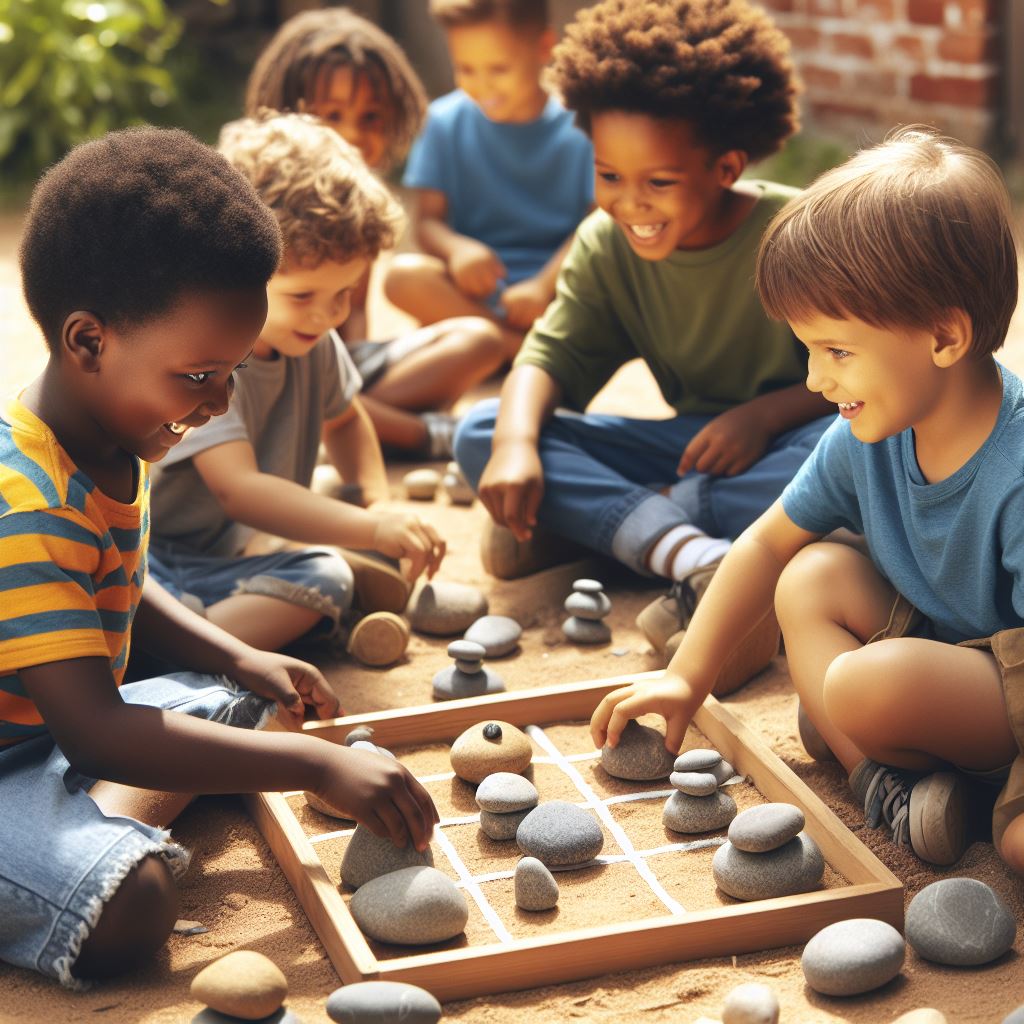
Rock Dominoes
Like the traditional tile game, rock dominoes helps children develop number sense and pattern matching ability. Use 28 rocks of similar size and shape. Paint or sticker the rocks with dots to represent the dominoes. Deal seven rocks to each player, with the remainder as the draw pile. Players take turns putting a rock that matches an end of the chain. If a play cannot be made, draw from the pile. The first player out of rocks wins.
Rocks provide an engaging, hands-on tool for learning and development. The activities described help build skills from math and literacy to creativity and logic – all while having fun. Exploring different ways to use rocks inspires imagination and a sense of discovery in children.
Rock Storytelling: Using Rocks to Spark Your Child’s Imagination
Rocks can be wonderful props for imaginative storytelling with children. Their interesting shapes, colours, and textures inspire creativity. Storytelling helps develop language skills and cognitive abilities in kids.
Find Inspiring Rocks
Look for rocks with features that remind you of something, like a face, animal or object. Smooth, rounded rocks or those with natural markings work well. You can also paint simple features on rocks to bring them to life. Provide a selection of rocks for your child to choose from.
Create Characters and Settings
Have your child pick a rock and ask them what it reminds them of. Help them develop it into a character for a story. Give the character a name, personality and backstory. Decide where the character lives and include details about the setting. Use additional rocks as other characters or parts of the setting.
Develop a Plot
Work with your child to create a simple plot for the story. There should be a problem or challenge for the main character to face. Help your child think of obstacles and how the character can overcome them. Keep plots lighthearted and fun for children. They can achieve a happy resolution in just a few sentences.
Tell the Story
Have your child pick up the rocks they chose for characters and settings. Holding the props helps bring the story to life for them. Ask your child to tell you the story they created. Gently prompt them with questions to encourage details and plot points. Praise your child for their creativity!

Extend the Play
Storytelling with rocks inspires imaginative, open-ended play. Your child can act out the story with the rocks, create sequels or entirely new stories. Provide craft materials so your child can make props, scenery and costumes for the rocks. This engaging, unstructured play helps with cognitive, social-emotional and language development.
With some inspiring rocks and guidance, you can spark your child’s imagination through storytelling. This simple yet engaging activity has many benefits for development and learning. Most of all, it can lead to lots of fun, quality time together.
FAQs: Fun Games and Activities for Kids Using Rocks
What are some simple games and activities I can do with rocks?
Some simple games and activities you can do with rocks include:
Rock sorting: Sorting rocks by colour, size, shape, texture or other properties helps children develop observation and classification skills. You can create graphs and charts to represent how the rocks were sorted.
Rock painting: Decorating rocks with paint, stickers or other materials boosts creativity and imagination. Children can make the rocks resemble animals, plants, numbers, letters or anything else.
Rock tic-tac-toe: Using 5 rocks of one colour and 5 of another, children can play the classic game of tic-tac-toe. This helps develop strategic thinking and logic skills.
Rock dominoes: With 28 rocks of similar size and shape, numbered or coloured to represent dominoes, children can play a fun math game. Matching the numbers or colours on the rocks practises counting, addition and pattern recognition.
Rock storytelling: Interesting rocks can spark children’s imagination. They can create stories around the rocks, developing characters, settings, problems and solutions. Storytelling with props helps build language and communication abilities.
How can rocks be used for learning and education?
Rocks provide an engaging tool for learning and education across many subjects:
Science: Rocks teach children about geology, the rock cycle and natural materials. They can classify rocks, learn how they form and investigate their properties.
Math: Activities like sorting, counting, measuring and graphing rocks help develop math skills. Games like dominoes and tic-tac-toe also boost strategic and logical thinking.
Art: Painting, drawing on and decorating rocks inspires creativity. Children can make pictures, sculptures, collages and more with rocks.
Language: Storytelling using rocks as characters or props helps children build vocabulary, language skills and communication abilities. They can create imaginative stories around the rocks.
Motor skills: Manipulating, stacking, sorting and arranging rocks improves hand-eye coordination and fine motor skills in children. Larger rocks also help develop gross motor skills.
Problem-solving: Challenging children to build structures, patterns or sculptures with rocks exercises problem-solving skills. They need to think logically about balance, stability and design.
Rocks provide an engaging multi-sensory learning tool for children that boosts skills across cognitive, social-emotional and physical areas of development. With some guidance, rocks can be used in creative ways to teach children of all ages.


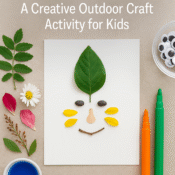


[…] crafts from things found in nature is a great way to keep your little ones busy. With over 900 ideas available online, you’re […]
[…] to create simple “inventions” inspired by their discoveries, such as leaf rubbings, rock paintings, or nature collages. This activity nurtures their curiosity about the natural world and fosters a […]